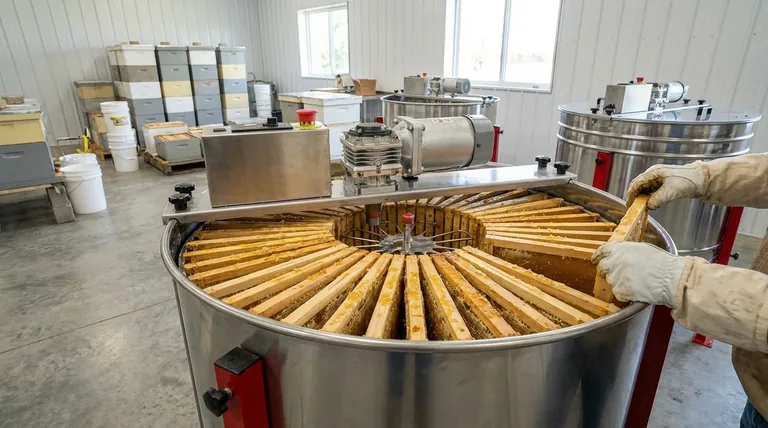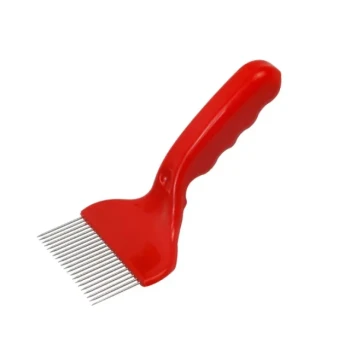The fundamental difference between a radial and a tangential honey extractor lies in how they position the frames for extraction. A radial extractor holds frames like the spokes of a wheel, allowing honey to be removed from both sides of the comb simultaneously. A tangential extractor holds the frame with one side of the honeycomb facing outward, requiring you to flip it halfway through to extract honey from the other side.
The choice between radial and tangential is not merely a design preference; it is a strategic decision that directly impacts the speed, labor, and scale of your honey harvesting operation.

The Core Mechanical Difference: Frame Orientation
The orientation of the frames inside the extractor's drum dictates how centrifugal force works to remove the honey. This single design choice creates two very different user experiences.
How a Radial Extractor Works
In a radial extractor, frames are placed vertically with their top bars facing the outer wall of the drum, similar to spokes on a wheel.
When the extractor spins, centrifugal force pulls honey out from the cells on both sides of the comb at the same time. The natural upward slope of the honeycomb cells facilitates this simultaneous extraction.
This design is highly efficient, as it eliminates the need to stop the process and manually handle the frames midway through.
How a Tangential Extractor Works
A tangential extractor holds the frames so that the flat side of the honeycomb faces the outer wall. The basket typically holds only a few frames this way.
As the drum spins, honey is extracted from the outward-facing side only.
To complete the process, you must stop the extractor, turn each frame around to expose the other side, and then spin it again. This makes the process inherently more labor-intensive.
Why This Difference Matters for Your Apiary
The mechanical design has direct consequences for your time, effort, and the number of hives you can reasonably manage.
Extraction Speed and Labor
Radial extractors are significantly faster. Because you don't have to flip frames, the workflow is much simpler and requires less manual intervention. This is a crucial advantage for processing honey from multiple hives.
Tangential extractors are slower and more hands-on. The need to stop, open the extractor, flip each frame, and restart adds considerable time and effort to the process.
Scale of Operation
The efficiency of radial extractors makes them the standard for beekeepers with larger operations, from serious hobbyists to commercial producers.
Tangential extractors are perfectly suitable for beginner beekeepers or those with only a handful of hives, where the extra time per frame is less of a concern.
Understanding the Trade-offs: Manual vs. Motorized
The power source is another critical factor that often aligns with the extractor type. While an extractor is either radial or tangential by design, it can be powered manually or with a motor.
Manual Extractors (The Hand Crank)
Manual extractors use a hand crank to spin the basket. They are cost-effective, simple, and don't require electricity, making them popular with new beekeepers.
Most entry-level manual extractors are tangential by design due to their simpler construction and suitability for small batches.
Motorized Extractors (Automatic)
Motorized extractors use an electric motor to spin the basket, often with variable speed controls. This dramatically reduces physical labor and provides a more consistent spin.
These are ideal for large-scale production, and the vast majority of radial extractors are motorized to maximize their inherent efficiency.
Making the Right Choice for Your Operation
Choosing the right extractor depends entirely on your current scale and future goals as a beekeeper.
- If your primary focus is a small hobby with 1-4 hives: A manual tangential extractor offers the best balance of affordability and function.
- If your primary focus is efficiency and you manage more than 5 hives: A motorized radial extractor is a worthwhile investment that will save you significant time and labor.
- If your primary focus is minimizing upfront cost above all else: A simple, manual tangential extractor is the most economical and reliable starting point.
Ultimately, understanding this core difference empowers you to select a tool that matches your ambition, ensuring your equipment supports your beekeeping journey.
Summary Table:
| Feature | Radial Extractor | Tangential Extractor |
|---|---|---|
| Frame Orientation | Frames placed like wheel spokes | Frames placed with one side facing out |
| Extraction Process | Extracts honey from both sides simultaneously | Requires flipping frames to extract the second side |
| Best For | Larger operations (5+ hives), efficiency | Small-scale hobbyists (1-4 hives), low cost |
| Typical Power Source | Usually motorized | Often manual |
Ready to scale your honey production efficiently?
As a trusted wholesale supplier to commercial apiaries and beekeeping equipment distributors, HONESTBEE provides the durable, high-performance radial and tangential extractors that growing operations depend on. Let our experts help you select the perfect equipment to maximize your harvest and minimize labor.
Contact HONESTBEE today for wholesale pricing and equipment recommendations tailored to your commercial needs.
Visual Guide

Related Products
- Electric 8 Frame Honey Spinner Extractor Equipment for Beekeeping
- HONESTBEE 72 Frame Industrial Electric Honey Extractor for Beekeeping
- HONESTBEE 3-Frame Manual Acrylic Honey Extractor
- electric honey extractor honey centrifuge 3 frame honey extractor stainless steel honey frame extractor
- 6 Frame Manual Stainless Steel Honey Extractor Beekeeping Equipment
People Also Ask
- What are the differences between manual and electric honey extractors? A Beekeeper's Guide to Power, Speed & Cost
- What are the benefits of using a honey extractor? Maximize Harvest & Save Bee Energy
- How long should you spin honey? Master the Art of Efficient, Damage-Free Extraction
- What machines are needed in beekeeping besides basic tools? Scale Your Honey Harvest Efficiently
- How long should you spin honey for? Master the Art of Efficient, Safe Extraction



















